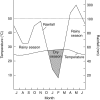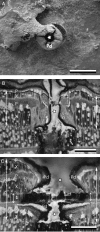A patchy growth via successive and simultaneous cambia: key to success of the most widespread mangrove species Avicennia marina?
- PMID: 18006508
- PMCID: PMC2701843
- DOI: 10.1093/aob/mcm280
A patchy growth via successive and simultaneous cambia: key to success of the most widespread mangrove species Avicennia marina?
Abstract
Background and aims: Secondary growth via successive cambia has been intriguing researchers for decades. Insight into the mechanism of growth layer formation is, however, limited to the cellular level. The present study aims to clarify secondary growth via successive cambia in the mangrove species Avicennia marina on a macroscopic level, addressing the formation of the growth layer network as a whole. In addition, previously suggested effects of salinity on growth layer formation were reconsidered.
Methods: A 1-year cambial marking experiment was performed on 80 trees from eight sites in two mangrove forests in Kenya. Environmental (soil water salinity and nutrients, soil texture, inundation frequency) and tree characteristics (diameter, height, leaf area index) were recorded for each site. Both groups of variables were analysed in relation to annual number of growth layers, annual radial increment and average growth layer width of stem discs.
Key results: Between trees of the same site, the number of growth layers formed during the 1-year study period varied from only part of a growth layer up to four growth layers, and was highly correlated to the corresponding radial increment (0-5 mm year(-1)), even along the different sides of asymmetric stem discs. The radial increment was unrelated to salinity, but the growth layer width decreased with increasing salinity and decreasing tree height.
Conclusions: A patchy growth mechanism was proposed, with an optimal growth at distinct moments in time at different positions around the stem circumference. This strategy creates the opportunity to form several growth layers simultaneously, as observed in 14 % of the studied trees, which may optimize tree growth under favourable conditions. Strong evidence was provided for a mainly endogenous trigger controlling cambium differentiation, with an additional influence of current environmental conditions in a trade-off between hydraulic efficiency and mechanical stability.
Figures





References
-
- APHA-AWWA-WEF. Standard methods for the examination of water and wastewater. Washington, DC: American Public Health Association; 1995.
-
- Artschwager E. The time factor in the differentiation of secondary xylem and phloem in pecan. American Journal of Botany. 1950;37:16–24.
-
- Baker RT. The Australian ‘grey mangrove’ (Avicennia officinalis, Linn.) Journal and Proceedings of the Royal Society of New South Wales. 1915;49:257–281.
-
- Ball MC. Interactive effects of salinity and irradiance on growth: implications for mangrove forest structure along salinity gradients. Trees. 2002;16:126–139.
-
- Bauch J, Dünisch O. Comparison of growth dynamics and wood characteristics of plantation-grown and primary forest Carapa guianensis in Central Amazonia. IAWA Journal. 2000;21:321–333.

